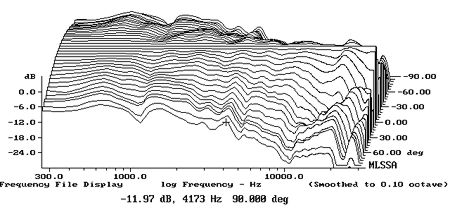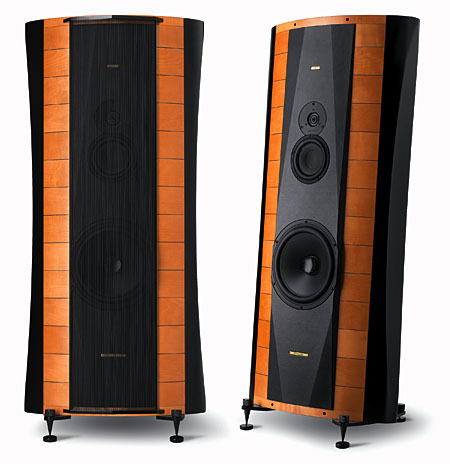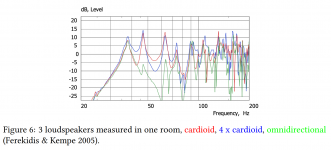There are three expert researchers who get quoted on here a lot: Linkwitz, Toole, and Geddes.
That's quite natural due to country and publications though team Finland (Backman, Louhivaara, Manninen, Salmi, Saunisto) has been more significant, experienced and inspiring with cardioid designs.
Here's a masters thesis from Finland by Olli Kantamaa (Aalto University) on Low-mid cardioid using active gradient cardioid:
"The listening test results were statistically analysed, showing significant improvements in clarity, absence of sound colourations, transient reproduction and accuracy of the virtual sound images improved with increasing LMF directivity. Sound quality impairments were not detected when the LMF directivity increased. The LMF directivity was the main factor contributing to the subjective assessment of the sound quality."
Improving Two–Way Loudspeaker Directivity, 2020
I've had that paper over a decade and built speakers with cardioid bass since 2004 so figure it out why I don't agree with anybody claiming that it's not valuable.
Why do you think it's valuable?
And what might those other factors be? Higher distortion, lower spl limit...?
If it's done well, cardioid (passive) is more than a little different with respect to mechanical compliance and it's interaction with electrical (Impedance) results.
Why do you think it's valuable?
Why wouldn't I think if it has been very flexible i.e. balanced in different rooms and locations. More balanced at once without adjustments than other types. At least six speakers in nine different rooms around Finland. I might call that knowing rather than thinking.
I quickly re-read the Kantamaa paper, and the biggest difference in measured room responses was in room decay (anechoic spl responses were equalized), to the advantage of cardioid. Distortion was not measured, by the way. Speakers were 2-way, no other specifications were given except responses and horizontal directivity graphs. Cardioid response 80- 600Hz was made by using second similar speaker behind the other (only woofer playing)
"Less coloured off–axis magnitude response in the DUT B reduces the in–room decay. DUT couples less to the room, the room decay is diminished and masking is decreased with the increased directivity."
Subjective tests were performed with only 6 participants, but statistial analysis (ANOVA) showed significant difference in preference of DUTs.
Now I wonder when will Genelec publish it's first cardioid speaker (I don't count the W371A)
ps. there is another paper by Kantamaa in Finnish, whrere speakers were 3-way https://www.akustinenseura.fi/wp-content/uploads/2019/10/akustiikkapaivat_2019_s248.pdf
https://www.linkedin.com/in/olli-kantamaa-7855a4b6/?originalSubdomain=fi
"Less coloured off–axis magnitude response in the DUT B reduces the in–room decay. DUT couples less to the room, the room decay is diminished and masking is decreased with the increased directivity."
Subjective tests were performed with only 6 participants, but statistial analysis (ANOVA) showed significant difference in preference of DUTs.
Now I wonder when will Genelec publish it's first cardioid speaker (I don't count the W371A)
ps. there is another paper by Kantamaa in Finnish, whrere speakers were 3-way https://www.akustinenseura.fi/wp-content/uploads/2019/10/akustiikkapaivat_2019_s248.pdf
https://www.linkedin.com/in/olli-kantamaa-7855a4b6/?originalSubdomain=fi
Last edited:
Now I wonder when will Genelec publish it's first cardioid speaker (I don't count the W371A)
I "think" they have made some tests 😉 New Ones with slot woofers are close to cardioid in single plane (ver or hor depending on rotation). That is quite adequate in their segment imo.
Also Taipuu Speakers has had resources to design cardioids (also at LF) but just one thing is probably missing; customers with thick wallet.
i want to remind folks here about using very wide baffle to achieve cardioid(ish) response at LF. Kimmosto had a clone of Sonus Faber Stradivari too (KS-585?), but I have never seen 3D measurements including backside of these Sonus Faber Stradivari Homage loudspeaker Measurements | Stereophile.com


Yes they might be difficult to position in a "normal family" living room... at least I would never get a permission! Actually I agree and that's why I turned to dipoles which have some special character as well.


Yes they might be difficult to position in a "normal family" living room... at least I would never get a permission! Actually I agree and that's why I turned to dipoles which have some special character as well.
Last edited:
Why wouldn't I think if it has been very flexible i.e. balanced in different rooms and locations. More balanced at once without adjustments than other types. At least six speakers in nine different rooms around Finland. I might call that knowing rather than thinking.
What is the nature of the low frequency system: is it multi-sub; one sub; a nearfield cardioid; only two main cardioid channels?
I included an image in the Kantamma LMF cardioid paper from Ferekidis, L. & Kempe, U. (2005). One cardioid vs one monopole vs four cardioid sources. It looks like one cardioid is superior to one monopole. If the low frequency system is restricted to only the two main channels (effectively one cardioid sub) then it looks like cardioid is better. But is a single low frequency cardioid better than a multi-sub monopole system, and is a multi-sub cardioid better than a multi-sub monopole?
Ferekidis, L. & Kempe, U. (2005), Controlling the Mode Excitation of Rooms by Using Multiple Low Frequency Cardioids in Multichannel Systems. Proc. Audio Eng. Soc. 118.
Attachments
What is the nature of the low frequency system:...?
two main cardioid channels
But is a single low frequency cardioid better than a multi-sub monopole system, and is a multi-sub cardioid better than a multi-sub monopole?
Probably #1 no and #2 yes.
But finally all depends on case; possibilities, preference, knowledge, time, gear and motivation. For example I don't prefer separate sub channel and don't tolerate rear right (due to ear damage) and rear is typically difficult...impossible in our living room so motivation to try anything more complex than stereo cardioid is very close to zero knowing that stereo cardioid works very well in all possible locations. Stereo monopole works okay in two possible locations with certain distance to front wall so I can and have survived without cardioids.
Last edited:
Smoothing/minimizing modes and getting smooth bass response at spot via EQ or multisub are overrated IMO, regarding music listening in stereo.
I have only limited experience with it (max 3 subs distributed), and that was in my small HT room. Abandoning a single subwoofer and now using two subs as 4-way speakers is an economical way to mix some modes and enhance imaging.
For good stereo reproduction of music instruments giving low freq tunes and transients with lots of harmonics , it is beneficial to use wide bandwidth radiators as a stereo pair. This way coherent phase relation between fundamental and harmonics and spatial imaging are best acheived. The "limits" of spatial perception (Schröder) are not fixed,but gliding and also room- and most likely also individually variating. (ref. Griesinger)
I have only limited experience with it (max 3 subs distributed), and that was in my small HT room. Abandoning a single subwoofer and now using two subs as 4-way speakers is an economical way to mix some modes and enhance imaging.
For good stereo reproduction of music instruments giving low freq tunes and transients with lots of harmonics , it is beneficial to use wide bandwidth radiators as a stereo pair. This way coherent phase relation between fundamental and harmonics and spatial imaging are best acheived. The "limits" of spatial perception (Schröder) are not fixed,but gliding and also room- and most likely also individually variating. (ref. Griesinger)
Last edited:
In what way a coherent phase relation between fundamentals below -say- 150Hz and their harmonics is beneficial? To my knowledge our hearing doesn't do anything with phase at low frequencies. And in most listening environments with only one or two sources coherent phase behavior is severely hampered by modal behavior of the sound field.
markbakk, that is only my guts feeling, based on personal experience. But I think it has to do with timbre/tonality of instruments. Aslos localization ef eg. drumbeats and eg. clasical orchestra's sound (nowdays bass is mixed in stereo unlike in vinyl era)
I also think that I can hear a difference with LR2 vs LR4 crossover, LR2 giving more natural sound and timbre.
I am no scientist and I know that many people disagree, but I've also read about similar experience (some people even prefer fullrange speakers without any crossover, can you believe that!)
I have read quite a lot of what Dr. David Griesinger has studied and written about, regarding spatial hearing and acoustics, and I think that he is a guru!
http://www.davidgriesinger.com/
http://www.davidgriesinger.com/IOA2011/IOA2011_preprint.doc
I also think that I can hear a difference with LR2 vs LR4 crossover, LR2 giving more natural sound and timbre.
I am no scientist and I know that many people disagree, but I've also read about similar experience (some people even prefer fullrange speakers without any crossover, can you believe that!)
I have read quite a lot of what Dr. David Griesinger has studied and written about, regarding spatial hearing and acoustics, and I think that he is a guru!
http://www.davidgriesinger.com/
http://www.davidgriesinger.com/IOA2011/IOA2011_preprint.doc
Last edited:
Human hearing is in fact more sensitive to group delay at low frequencies than at higher ones (> about 500 Hz). Thus a BR enclosure indeed may sound "slow" - IF its group delay really is quite high (which in principle as well as in real world applications can be avoided).
Also, at "lowish" frequencies there is some merit in avoiding steep crossover slopes.
Of course all of this will be messed up by room modes in small rooms. But does that mean that group delay (/phase) doesn't matter at all? I suppose not ...
Also, at "lowish" frequencies there is some merit in avoiding steep crossover slopes.
Of course all of this will be messed up by room modes in small rooms. But does that mean that group delay (/phase) doesn't matter at all? I suppose not ...
But finally all depends on case; possibilities, preference, knowledge, time, gear and motivation. For example I don't prefer separate sub channel and don't tolerate rear right (due to ear damage) and rear is typically difficult...impossible in our living room so motivation to try anything more complex than stereo cardioid is very close to zero knowing that stereo cardioid works very well in all possible locations. Stereo monopole works okay in two possible locations with certain distance to front wall so I can and have survived without cardioids.
I agree. On a case-by-case evaluation, something might make sense that doesn't otherwise make sense. Or use case such as side channels where you want a wide polar pattern so cardioid low-mid would degrade performance if you have space but might help if you don't.
If you can't have -- or don't want -- multi-sub then a single cardioid (alternatively, two main channels w/ cardioid bass) makes sense.
In general, it seems like cardioid's big small room payoff is in the 200-500Hz range Geddes and Silas identified earlier. I'm glad Olli Kantamaa wrote his masters thesis on the subject. Personally, I derived more value with 500-1,000Hz cardioid than 200-500Hz. I could turn off the 200-500Hz and notice a difference but not a general preference. Turning cardioid on improved clarity but turning it off improved "warmth". If used as a center channel then I think cardioid 200-500Hz supplies a clear preference, which reinforces the idea of case-by-case evaluation.
Smoothing/minimizing modes and getting smooth bass response at spot via EQ or multisub are overrated IMO, regarding music listening in stereo.
If the end result is smooth then it isn't overrated.
"When my team and I recently conducted a consumer study on loudspeakers, we uncovered that bass quality alone contributed 30% towards the overall listeners’ preference." - Sean Olive
Bass contributes just under a 3rd to listener preference. As long as someone isn't restricted by limitations they should definitely go multi-sub.
A DIYer using the Dutch & Dutch 8C as inspiration has the opportunity to take the good and improve the bad. The 8C bass is bad. It's a limitation imposed by fitting the speaker into a specific box size. They're really smart about how they do it but they're operating under constraints.
You definitely want to extract the bass elements from the 8C and distribute them around the room. You don't want to keep them in a two channel configuration. Unless you have to keep them in two channel for some reason.
Here's a thread on a DIY Dutch and Dutch 8C inspired design by Jag768
To the credits of this person, it wasn't (entirely) inspired by the 8C
The 8C wasn't officially around even when he started his idea.
Last edited:
In what way a coherent phase relation between fundamentals below -say- 150Hz and their harmonics is beneficial? To my knowledge our hearing doesn't do anything with phase at low frequencies. And in most listening environments with only one or two sources coherent phase behavior is severely hampered by modal behavior of the sound field.
Nor phase, nor time delay, nor amplitude difference.
Humans just can't localize any sounds under 80-150Hz.
Just dive into your standard acoustics books or papers and you will find countless of experiments and theories by this.
Not only that, but even in the case it was (just about) possible, most listening rooms are way to small to be of any significance when looking at the size of these wave lengths.
Even more so when a listener sits right in between those sources.
Not to talk about the fact that any room discrepancies (nodes, reflections and what have you) are far more significant.
Geddes is right that this is an entire different story with BIG venues.
Orders of magnitude bigger than your average listening room.
In that situation it's not only being used for the listening experience, but also to keep noise pollution at bay. Or even create sound "dead-zones"
Usually this is being done by using multiple mono subs to create some kind of (semi) cardiod or dipole.
Just a totally different animal.
In the end trying to create a cardiod that would work at lower frequencies at many cases/situations is a lot more limited than going for a multi-sub solution.
You're basically talking in terms of a fully case depended solution.
While not even tackling all the issues you will have at those lower frequencies.
My experience is that a multisub is even fine by a lot of non-audio-enthusiasts, as long as you blend it nicely with the environment.
Which can be very easily done with some simple subwoofers.
A lot of times, two is already a big improvement, with three you can tackle many situations and with 4 you can't really go wrong anymore.
So it's more about practicality than anything else.
OMG Is this thread rebooted to some really bad science claiming that e.g. phase, GD and source type does not matter?
No offense, but I don't know of any science that does point out the importance of phase at low frequencies. And since no one answered my question in #72 yet, I am still waiting (Griesinger published none on the specific subject as far as I can see, but frankly I hate it when I have to do the paperwork myself).
I wouldn't state that the posts of b_force are based on bad science. He could have mentioned the scientific works (I know he knows them) but I guess laziness caught him 😉. And since this is about cloning the 8C, we might stop arguing about cardioid basses, because it has none.
I wouldn't state that the posts of b_force are based on bad science. He could have mentioned the scientific works (I know he knows them) but I guess laziness caught him 😉. And since this is about cloning the 8C, we might stop arguing about cardioid basses, because it has none.
Last edited:
- Home
- Loudspeakers
- Multi-Way
- Resistive port cardioid active speaker insipired by D&D 8C
